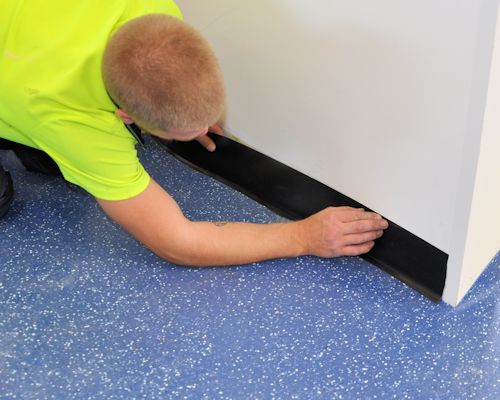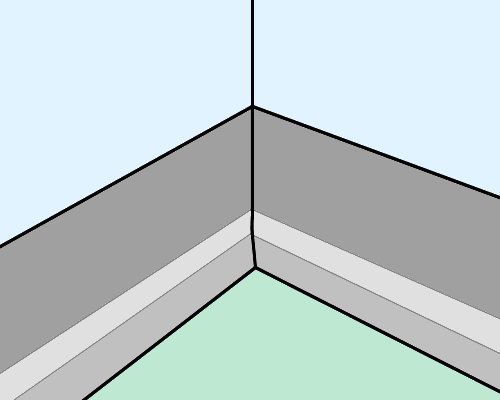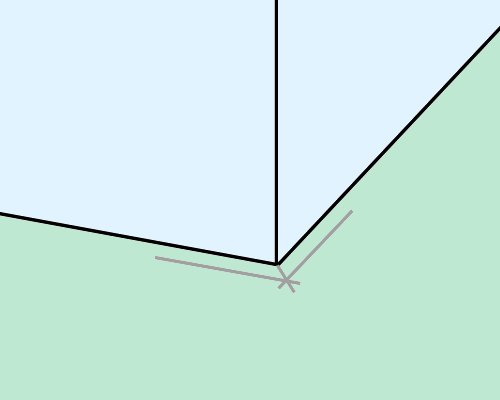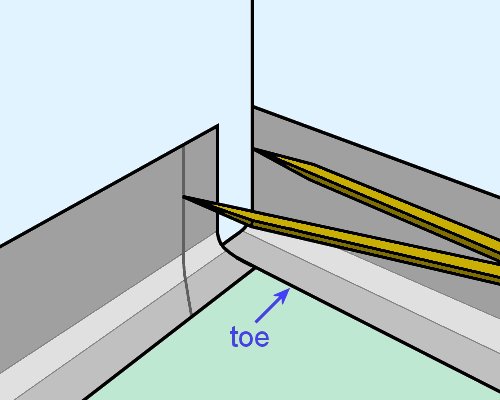Fitting cove skirting
 Audio for slide 1 (mp3 |6|KB)
Audio for slide 1 (mp3 |6|KB)
Cove skirting is an extruded vinyl product that's stuck to the wall around the floor perimeter. It's sometimes called:
- feather edge skirting, because it's tapered at the top and toe, or
- sit-on cove skirting, because it sits on top of the floor covering.
The product is very flexible, so it can either be mitred at the corners, or simply wrapped around with the aid of relief cuts. It is often supplied in 15 metre coils.

 Audio for slide 4 (mp3 |6|KB)
Audio for slide 4 (mp3 |6|KB)
- Cut the coving and chamfer the underside of the cut to ensure a tight fit.
- Stick the second piece to the toe of the first piece.
To fit a wrap-around internal corner, roll the skirting around the corner and put a cut in the toe. Then push the skirting tightly into position, and double cut a 45 degree mitre into the toe.

 Audio for slide 5 (mp3 |6|KB)
Audio for slide 5 (mp3 |6|KB)
External corners
To fit an external mitred corner:
- Place a piece of skirting along one wall, extending past the corner, and draw a pencil line on the floor against the toe. Then do the same on the other wall.
- Draw a line from the corner to the intersection of the two lines to mark the angle of the mitre.

 Audio for slide 6 (mp3 |6|KB)
Audio for slide 6 (mp3 |6|KB)
- Place the first piece of coving in position and draw the mitre cut on top of the toe with a pencil. Then draw a vertical line down the back of the coving at the wall corner - using a small scrap as a spacer.
Push a knife into the back of the coving at two points on the line - this will show as two white marks on the front of the coving, which can be used as guide marks - and then draw a corresponding line on the front.

 Audio for slide 9 (mp3 |6|KB)
Audio for slide 9 (mp3 |6|KB)
- Cut and fit the second piece.
To fit a wrap-around external corner, gently heat the skirting to improve its flexibility and wrap the skirting around the corner using a hand roller.
If the external corner is tight, you may need to cut a groove in the back of the skirting to about ¼ of the depth, so it bends around the corner more easily.


Learning activity
Audio 10 (mp3 |6|KB)The link below will take you to a PDF document issued by Armstrong called 'Feather edge skirting'.
Read through the document and answer the following questions:
What two sizes are available in feather edge skirting?
What adhesives are recommended? State the brand name and type of adhesive for each one.
How is the adhesive applied?

 Go to Motifs and patterns
Go to Motifs and patterns


